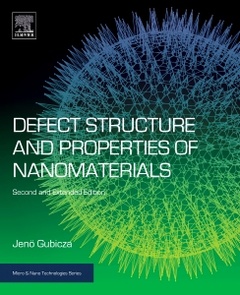Defect Structure and Properties of Nanomaterials (2nd Ed.) Second and Extended Edition
Auteur : Gubicza J

Defect Structure and Properties of Nanomaterials: Second and Extended Edition covers a wide range of nanomaterials including metals, alloys, ceramics, diamond, carbon nanotubes, and their composites. This new edition is fully revised and updated, covering important advances that have taken place in recent years.
Nanostructured materials exhibit unique mechanical and physical properties compared with their coarse-grained counterparts, therefore these materials are currently a major focus in materials science. The production methods of nanomaterials affect the lattice defect structure (vacancies, dislocations, disclinations, stacking faults, twins, and grain boundaries) that has a major influence on their mechanical and physical properties.
In this book, the production routes of nanomaterials are described in detail, and the relationships between the processing conditions and the resultant defect structure, as well as the defect-related properties (e.g. mechanical behavior, electrical resistance, diffusion, corrosion resistance, thermal stability, hydrogen storage capability, etc.) are reviewed.
In particular, new processing methods of nanomaterials are described in the chapter dealing with the manufacturing procedures of nanostructured materials. New chapters on (i) the experimental methods for the study of lattice defects, (ii) the defect structure in nanodisperse particles, and (iii) the influence of lattice defects on electrical, corrosion, and diffusion properties are included, to further enhance what has become a leading reference for engineering, physics, and materials science audiences.
1. Processing Methods of Nanomaterials 2. Characterization Methods of Lattice Defects 3. Defect Structure in Bulk Nanomaterials Processed by Severe Plastic Deformation 4. Defect Structure in Low Stacking Fault Energy Nanomaterials 5. Lattice Defects in Nanoparticles and Nanomaterials Sintered From Nanopowders 6. Lattice Defects in Nanocrystalline Films and Multilayers 7. Correlation Between Defect Structure and Mechanical Properties of Nanocrystalline Materials 8. Defect Structure and Properties of Metal Matrix–Carbon Nanotube Composites 9. Effect of Lattice Imperfections on Electrical Resistivity of Nanomaterials 10. Lattice Defects and Diffusion in Nanomaterials 11. Relationship Between Microstructure and Hydrogen Storage Properties of Nanomaterials 12. Thermal Stability of Defect Structures in Nanomaterials
Materials Scientists and Engineers working in the areas of nanomaterials design, processing and engineering.
- Provides a detailed overview of processing methods, defect structure, and defect-related mechanical and physical properties of nanomaterials
- Covers a wide range of nanomaterials including metals, alloys, ceramics, diamond, carbon nanotubes, and their composites
- Includes new chapters covering recent advances in both processing techniques and methods for the study of lattice defects
- Provides valuable information that will help materials scientists and engineers highlight lattice defects and the related mechanical and physical properties
Date de parution : 03-2017
Ouvrage de 410 p.
19x23.3 cm
Thèmes de Defect Structure and Properties of Nanomaterials :
Mots-clés :
Absorption; Activation energy; Calorimetry; Carbon nanotube; Catalyst; Composite; Conductivity; Contracting volume model; Copper alloys; Crystallization of bulk amorphous materials; Desorption; Disclination; Dislocation density; Dislocation dissociation; Dislocation slip systems; Dislocation; Dislocations; Ductility; Electrical conductivity; Electrical resistivity; Electrical resistometry; Electrodeposition; Electro-explosion of wire; Electron backscatter diffraction; Elongation to failure; Excess vacancies; Gibbs�Thomson effect; Grain boundary diffusion; Grain boundary misorientation; Grain boundary; Grain growth during consolidation; Grain growth; Grain refinement; Grain size; High resolution transmission electron microscopy; Hot isostatic pressing; Hydrogen storage; Hydrothermal reaction; Implantation; Inert gas condensation; Interagglomerate and intraagglomerate interfaces; Interface energy; Inverse Hall�Petch behavior; Low stacking fault energy; Magnetron sputtering; Metal matrix; Milling; Misfit dislocation; Multilayer; Nanoparticle; Nonequilibrium grain boundary; Partial dislocation; Positron annihilation spectroscopy; Powder metallurgy; Precipitation; Recovery; Recrystallization; Relaxed grain boundary; Self-annealing; Severe plastic deformation; Silver; Slow and fast diffusion paths; Softening; Sonochemical synthesis; Spark plasma sintering; Stacking fault; Strain rate; Strength; Texture; Thin film; Twin boundary; Twin fault probability; Twin fault; Twinning; Untwinning; Vacancy annihilation; Vacancy concentration; Vacancy; X-ray line profile analysis; Yield strength



